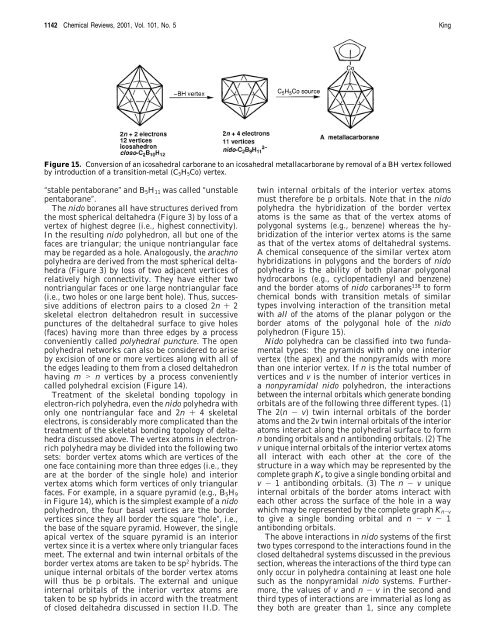Three-Dimensional Aromaticity in Polyhedral Boranes and Related ...
Three-Dimensional Aromaticity in Polyhedral Boranes and Related ...
Three-Dimensional Aromaticity in Polyhedral Boranes and Related ...
You also want an ePaper? Increase the reach of your titles
YUMPU automatically turns print PDFs into web optimized ePapers that Google loves.
1142 Chemical Reviews, 2001, Vol. 101, No. 5 K<strong>in</strong>g<br />
Figure 15. Conversion of an icosahedral carborane to an icosahedral metallacarborane by removal of a BH vertex followed<br />
by <strong>in</strong>troduction of a transition-metal (C5H5Co) vertex.<br />
“stable pentaborane” <strong>and</strong> B5H11 was called “unstable<br />
pentaborane”.<br />
The nido boranes all have structures derived from<br />
the most spherical deltahedra (Figure 3) by loss of a<br />
vertex of highest degree (i.e., highest connectivity).<br />
In the result<strong>in</strong>g nido polyhedron, all but one of the<br />
faces are triangular; the unique nontriangular face<br />
may be regarded as a hole. Analogously, the arachno<br />
polyhedra are derived from the most spherical deltahedra<br />
(Figure 3) by loss of two adjacent vertices of<br />
relatively high connectivity. They have either two<br />
nontriangular faces or one large nontriangular face<br />
(i.e., two holes or one large bent hole). Thus, successive<br />
additions of electron pairs to a closed 2n + 2<br />
skeletal electron deltahedron result <strong>in</strong> successive<br />
punctures of the deltahedral surface to give holes<br />
(faces) hav<strong>in</strong>g more than three edges by a process<br />
conveniently called polyhedral puncture. The open<br />
polyhedral networks can also be considered to arise<br />
by excision of one or more vertices along with all of<br />
the edges lead<strong>in</strong>g to them from a closed deltahedron<br />
hav<strong>in</strong>g m > n vertices by a process conveniently<br />
called polyhedral excision (Figure 14).<br />
Treatment of the skeletal bond<strong>in</strong>g topology <strong>in</strong><br />
electron-rich polyhedra, even the nido polyhedra with<br />
only one nontriangular face <strong>and</strong> 2n + 4 skeletal<br />
electrons, is considerably more complicated than the<br />
treatment of the skeletal bond<strong>in</strong>g topology of deltahedra<br />
discussed above. The vertex atoms <strong>in</strong> electronrich<br />
polyhedra may be divided <strong>in</strong>to the follow<strong>in</strong>g two<br />
sets: border vertex atoms which are vertices of the<br />
one face conta<strong>in</strong><strong>in</strong>g more than three edges (i.e., they<br />
are at the border of the s<strong>in</strong>gle hole) <strong>and</strong> <strong>in</strong>terior<br />
vertex atoms which form vertices of only triangular<br />
faces. For example, <strong>in</strong> a square pyramid (e.g., B5H9<br />
<strong>in</strong> Figure 14), which is the simplest example of a nido<br />
polyhedron, the four basal vertices are the border<br />
vertices s<strong>in</strong>ce they all border the square “hole”, i.e.,<br />
the base of the square pyramid. However, the s<strong>in</strong>gle<br />
apical vertex of the square pyramid is an <strong>in</strong>terior<br />
vertex s<strong>in</strong>ce it is a vertex where only triangular faces<br />
meet. The external <strong>and</strong> tw<strong>in</strong> <strong>in</strong>ternal orbitals of the<br />
border vertex atoms are taken to be sp 2 hybrids. The<br />
unique <strong>in</strong>ternal orbitals of the border vertex atoms<br />
will thus be p orbitals. The external <strong>and</strong> unique<br />
<strong>in</strong>ternal orbitals of the <strong>in</strong>terior vertex atoms are<br />
taken to be sp hybrids <strong>in</strong> accord with the treatment<br />
of closed deltahedra discussed <strong>in</strong> section II.D. The<br />
tw<strong>in</strong> <strong>in</strong>ternal orbitals of the <strong>in</strong>terior vertex atoms<br />
must therefore be p orbitals. Note that <strong>in</strong> the nido<br />
polyhedra the hybridization of the border vertex<br />
atoms is the same as that of the vertex atoms of<br />
polygonal systems (e.g., benzene) whereas the hybridization<br />
of the <strong>in</strong>terior vertex atoms is the same<br />
as that of the vertex atoms of deltahedral systems.<br />
A chemical consequence of the similar vertex atom<br />
hybridizations <strong>in</strong> polygons <strong>and</strong> the borders of nido<br />
polyhedra is the ability of both planar polygonal<br />
hydrocarbons (e.g., cyclopentadienyl <strong>and</strong> benzene)<br />
<strong>and</strong> the border atoms of nido carboranes 138 to form<br />
chemical bonds with transition metals of similar<br />
types <strong>in</strong>volv<strong>in</strong>g <strong>in</strong>teraction of the transition metal<br />
with all of the atoms of the planar polygon or the<br />
border atoms of the polygonal hole of the nido<br />
polyhedron (Figure 15).<br />
Nido polyhedra can be classified <strong>in</strong>to two fundamental<br />
types: the pyramids with only one <strong>in</strong>terior<br />
vertex (the apex) <strong>and</strong> the nonpyramids with more<br />
than one <strong>in</strong>terior vertex. If n is the total number of<br />
vertices <strong>and</strong> v is the number of <strong>in</strong>terior vertices <strong>in</strong><br />
a nonpyramidal nido polyhedron, the <strong>in</strong>teractions<br />
between the <strong>in</strong>ternal orbitals which generate bond<strong>in</strong>g<br />
orbitals are of the follow<strong>in</strong>g three different types. (1)<br />
The 2(n - v) tw<strong>in</strong> <strong>in</strong>ternal orbitals of the border<br />
atoms <strong>and</strong> the 2v tw<strong>in</strong> <strong>in</strong>ternal orbitals of the <strong>in</strong>terior<br />
atoms <strong>in</strong>teract along the polyhedral surface to form<br />
n bond<strong>in</strong>g orbitals <strong>and</strong> n antibond<strong>in</strong>g orbitals. (2) The<br />
v unique <strong>in</strong>ternal orbitals of the <strong>in</strong>terior vertex atoms<br />
all <strong>in</strong>teract with each other at the core of the<br />
structure <strong>in</strong> a way which may be represented by the<br />
complete graph Kv to give a s<strong>in</strong>gle bond<strong>in</strong>g orbital <strong>and</strong><br />
v - 1 antibond<strong>in</strong>g orbitals. (3) The n - v unique<br />
<strong>in</strong>ternal orbitals of the border atoms <strong>in</strong>teract with<br />
each other across the surface of the hole <strong>in</strong> a way<br />
which may be represented by the complete graph Kn-v<br />
to give a s<strong>in</strong>gle bond<strong>in</strong>g orbital <strong>and</strong> n - v - 1<br />
antibond<strong>in</strong>g orbitals.<br />
The above <strong>in</strong>teractions <strong>in</strong> nido systems of the first<br />
two types correspond to the <strong>in</strong>teractions found <strong>in</strong> the<br />
closed deltahedral systems discussed <strong>in</strong> the previous<br />
section, whereas the <strong>in</strong>teractions of the third type can<br />
only occur <strong>in</strong> polyhedra conta<strong>in</strong><strong>in</strong>g at least one hole<br />
such as the nonpyramidal nido systems. Furthermore,<br />
the values of v <strong>and</strong> n - v <strong>in</strong> the second <strong>and</strong><br />
third types of <strong>in</strong>teractions are immaterial as long as<br />
they both are greater than 1, s<strong>in</strong>ce any complete

















